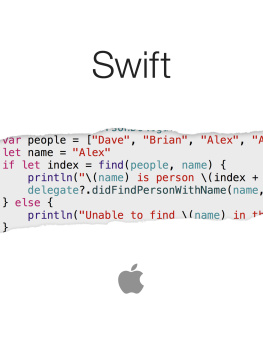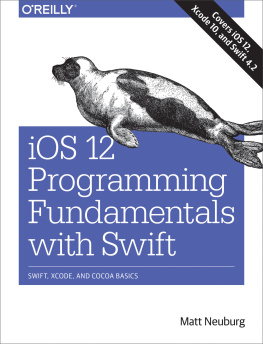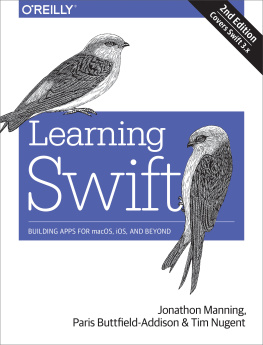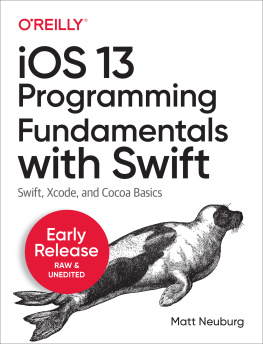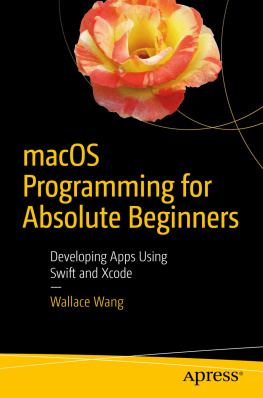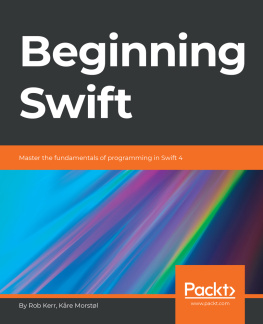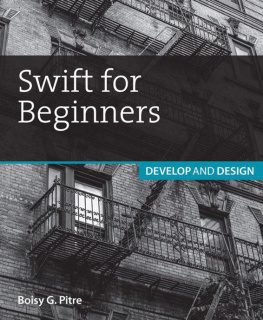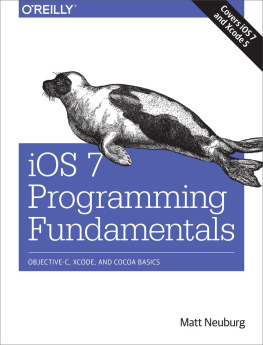iOS 9 Programming Fundamentals with Swift
Swift, Xcode, and Cocoa Basics
Matt Neuburg
Preface
On June 2, 2014, Apples WWDC keynote address ended with a shocking announcement: We have a new programming language. This came as a huge surprise to the developer community, which was accustomed to Objective-C, warts and all, and doubted that Apple could ever possibly relieve them from the weight of its venerable legacy. The developer community, it appeared, had been wrong.
Having picked themselves up off the floor, developers immediately began to examine this new language Swift studying it, critiquing it, and deciding whether to use it. My own first move was to translate all my existing iOS apps into Swift; this was enough to convince me that, for all its faults, Swift deserved to be adopted by new students of iOS programming, and that my books, therefore, should henceforth assume that readers are using Swift.
The Swift language is designed from the ground up with these salient features:
Object-orientation Swift is a modern, object-oriented language. It is purely object-oriented: Everything is an object. Clarity Swift is easy to read and easy to write, with minimal syntactic sugar and few hidden shortcuts. Its syntax is clear, consistent, and explicit. Safety Swift enforces strong typing to ensure that it knows, and that you know, what the type of every object reference is at every moment. Economy Swift is a fairly small language, providing some basic types and functionalities and no more. The rest must be provided by your code, or by libraries of code that you use such as Cocoa. Memory management Swift manages memory automatically. You will rarely have to concern yourself with memory management. Cocoa compatibility The Cocoa APIs are written in C and Objective-C. Swift is explicitly designed to interface with most of the Cocoa APIs.
These features make Swift an excellent language for learning to program iOS.
The alternative, Objective-C, still exists, and you can use it if you like. Indeed, it is easy to write an app that includes both Swift code and Objective-C code; and you may have reason to do so. Objective-C, however, lacks the very advantages that Swift offers. Objective-C agglomerates object-oriented features onto C. It is therefore only partially object-oriented; it has both objects and scalar data types, and its objects have to be slotted into one particular C data type (pointers). Its syntax can be difficult and tricky; reading and writing nested method calls can make ones eyes glaze over, and it invites hacky habits such as implicit nil-testing. Its type checking can be and frequently is turned off, resulting in programmer errors where a message is sent to the wrong type of object and the program crashes. It uses manual memory management; the recent introduction of ARC (automatic reference counting) has alleviated some of the programmer tedium and has greatly reduced the likelihood of programmer error, but errors are still possible, and memory management ultimately remains manual.
Recent revisions and additions to Objective-C ARC, synthesis and autosynthesis, improved literal array and dictionary syntax, blocks have made it easier and more convenient, but such patches have also made the language even larger and possibly even more confusing. Because Objective-C must encompass C, there are limits to how far it can be extended and revised. Swift, on the other hand, is a clean start. If you were to dream of completely revising Objective-C to create a better Objective-C, Swift might be what you would dream of. It puts a modern, rational front end between you and the Cocoa Objective-C APIs.
Therefore, Swift is the programming language used throughout this book. Nevertheless, the reader will also need some awareness of Objective-C (including C). The Foundation and Cocoa APIs, the built-in commands with which your code must interact in order to make anything happen on an iOS device, are still written in C and Objective-C. In order to interact with them, you have to know what those languages would expect. For example, in order to pass a Swift array where an NSArray is expected, you need to know what consitutes an object acceptable as an element of an Objective-C NSArray.
Therefore, in this edition, although I do not attempt to teach Objective-C, I do describe it in enough detail to allow you to read it when you encounter it in the documentation and on the Internet, and I occasionally show some Objective-C code. , on Cocoa, is really all about learning to think the way Objective-C thinks because the structure and behavior of the Cocoa APIs are fundamentally based on Objective-C. And the book ends with an appendix that details how Swift and Objective-C communicate with one another, as well as detailing how your app can be written partly in Swift and partly in Objective-C.
The Scope of This Book
This book is actually one of a pair with my Programming iOS 9 , which picks up exactly where this book leaves off. They complement and supplement one another. The two-book architecture should, I believe, render the size and scope of each book tractable for readers. Together, they provide a complete grounding in the knowledge needed to begin writing iOS apps; thus, when you do start writing iOS apps, youll have a solid and rigorous understanding of what you are doing and where you are heading. If writing an iOS program is like building a house of bricks, this book teaches you what a brick is and how to handle it, while Programming iOS 9 hands you some actual bricks and tells you how to assemble them.
When you have read this book, youll know about Swift, Xcode, and the underpinnings of the Cocoa framework, and you will be ready to proceed directly to Programming iOS 9 . Conversely, Programming iOS 9 assumes a knowledge of this book; it begins, like Homers Iliad , in the middle of the story, with the reader jumping with all four feet into views and view controllers, and with a knowledge of the language and the Xcode IDE already presupposed. If you started reading Programming iOS 9 and wondered about such unexplained matters as Swift language basics, the UIApplicationMain function, the nib-loading mechanism, Cocoa patterns of delegation and notification, and retain cycles, wonder no longer I didnt explain them there because I do explain them here.
The three parts of this book teach the underlying basis of all iOS programming:
- REPL. My focus here is real-life iOS programming, and my explanation of Swift therefore concentrates on those common, practical aspects of the language that, in my experience, actually come into play in the course of programming iOS.
- turns to Xcode, the world in which all iOS programming ultimately takes place. It explains what an Xcode project is and how it is transformed into an app, and how to work comfortably and nimbly with Xcode to consult the documentation and to write, navigate, and debug code, as well as how to bring your app through the subsequent stages of running on a device and submission to the App Store. There is also a very important chapter on nibs and the nib editor (Interface Builder), including outlets and actions as well as the mechanics of nib loading; however, such specialized topics as autolayout constraints in the nib are postponed to the other book.
- introduces the Cocoa Touch framework. When you program for iOS, you take advantage of a suite of frameworks provided by Apple. These frameworks, taken together, constitute Cocoa; the brand of Cocoa that provides the API for programming iOS is Cocoa Touch. Your code will ultimately be almost entirely about communicating with Cocoa. The Cocoa Touch frameworks provide the underlying functionality that any iOS app needs to have. But to use a framework, you have to think the way the framework thinks, put your code where the framework expects it, and fulfill many obligations imposed on you by the framework. To make things even more interesting, Cocoa uses Objective-C, while youll be using Swift: you need to know how your Swift code will interface with Cocoas features and behaviors. Cocoa provides important foundational classes and adds linguistic and architectural devices such as categories, protocols, delegation, and notifications, as well as the pervasive responsibilities of memory management. Keyvalue coding and keyvalue observing are also discussed here.

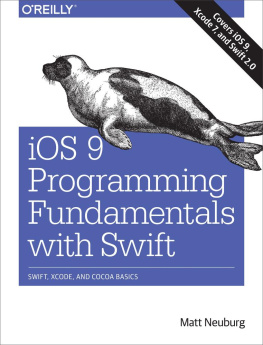
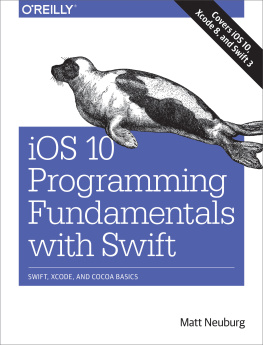
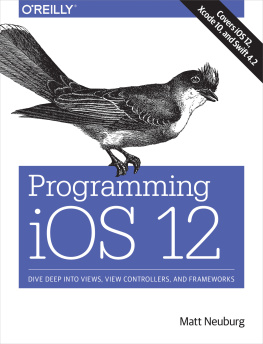
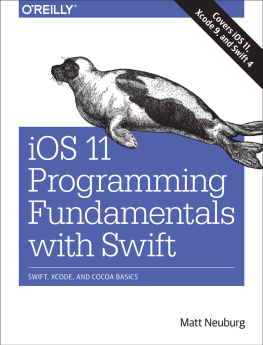
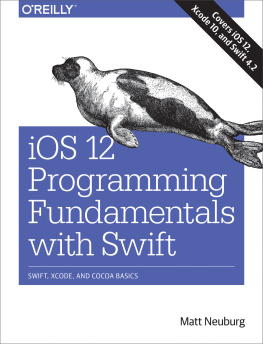
![Neuburg - Programming iOS 8 : [dive deep into views, view controllers, and frameworks; covers Swift, iOS 8.1, Xcode 6.1]](/uploads/posts/book/108865/thumbs/neuburg-programming-ios-8-dive-deep-into.jpg)

